Story and color photos by Jonathan Sharp
You may not be that familiar with Lingotto but if you have seen the original (and by far the best version) of The Italian Job, you may recall the scene in the film where the three Mini Coopers containing the stolen gold are pursued by the Police in their Alfas around a banked test track. That test track is on the roof of Lingotto, the Fiat factory which is located in a suburb of Turin.
The movie was again shown on the U.K. Channel 4 TV as part of their Christmas television schedule this year. It has become a bit of a tradition over the years for them to do so, and reminded me that the once state-of-the-art Fiat factory, is now – among other things – an upmarket hotel. I always wanted to stay there and the opportunity arose in early December when my wife and I decided to spend a weekend in Italy to stock up on Italian Christmas goodies, enjoy the artistic Christmas lights, and for us to visit the nearby Museo dell’Automobile.
In a series of visits to the U.S. prior to WWI, Giovanni Agnelli studied Henry Ford’s method of production line assembly in Detroit and decided to commission a factory in Turin to build the companies cars using the same methods. The factory takes its name from the largest farm house in what, in 1916 when building commenced, was an agricultural area on the outskirts of Turin. The original design of the factory was the work of the architect/engineer Giacomo Matte Trucco who also worked with the designers Francesco Cartasegna and Vittorio Bonade Bottino on its construction.Even before WWI Fiat was expanding automobile production; the advent of the war accelerated the process as Fiat was also making trucks, marine engines, tanks, and aircraft. Profits were put back into the business and the factory was constructed in as one wag put it, “a field of flowers belonging to Agnelli.” Construction was completed by 1922. Like Ford’s Rouge River Rouge plant, the new factory was self-contained, truly state of the art, and spearheaded an astonishing spurt in production.
The Lingotto factory was the first example of modular construction using reinforced concrete and it is constructed in the form of two parallel buildings, each 507 meters (1662 ft) in length, 5 stories high and each arm is joined in three places by 5 story high office linkways. At each end of the building there was a spiral ramp linking each floor. The building itself had an internal volume of approximately one million cubic meters.
Raw material entered into the building at ground floor level, and the finished product was then driven onto the roof top track for testing. The products were then driven off the building via the spiral ramp directly to the adjourning railway yards to be distributed worldwide. It is these railway lines and also the close proximity to the river Po on the opposite side of the factory that dictated that the production line be spiraled upwards rather than laid out horizontally as was the case in the Ford factories in Detroit.
Over the years Lingotto built many of the most famous Fiat models including the Balilla and the Topolino. By the 1970s the factory had become outmoded and was finally closed in 1982.* However, unlike its inspirations in Detroit, a further use for the factory was sought and in 1985 the Genoese Architect Renzo Piano was commissioned to regenerate the factory.
The building now contains an exhibition hall (Lingottoe Fiere), an auditorium, two hotels, a large shopping and restaurant gallery, and the Engineering faculty of the Turin Polytechnic. The Pinacoteca Giovanni e Marella Agnelli Art Gallery is located on the roof together with a restaurant and “The Bubble” which, to my mind, is probably the most striking exterior feature of the makeover. It is a glass dome meeting room for up to 25 persons with an attached helipad and is located, like the Art Gallery and an upmarket restaurant on the roof of one of the connecting buildings situated between each arm of the factory. Whilst the interior of the building has completely changed, the exterior and connecting ramps at each end remain as they were during the factory’a glory days. Indeed, to get between the various floors of the shopping gallery one can still walk up and down the spiral ramps, which is so much nicer than using an escalator. The office building in front of the river facing side of the factory which was built in 1928 still contains the Head offices of the Fiat group.
As my wife and entered into the NH Lingotto Hotel reception area, I knew it was going to be my type of hotel because there in the corner was a car. My initial thoughts were “Wow! a Studebaker – that’s a strange thing to see in Turin” but closer inspection revealed the car to be the Lancia Loraymo, which now forms part of the Lancia Company’s Historic Collection, and was on loan to the Hotel. The Loraymo was designed by Raymond Loewy and is based on a 1959 2500cc Flaminia. The engine was tuned by Nardi. The body was built by Motto and the finished example was first displayed to the public at the 1960 Paris Motor Show.
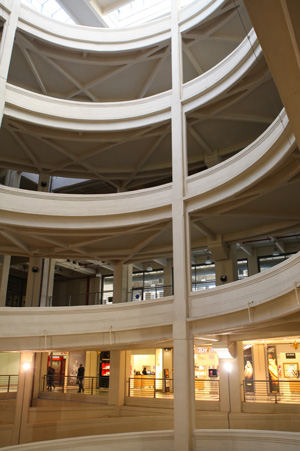
The spiral ramp at the City end of the building which now forms part of the Super 8 shopping center, make sure you bring your credit card if you enter into here.
The Hotel interior is very modern and spacious, making full use of the original height of each floor of the building. I had to wonder which part of the construction of the motor cars took place it what was now our very large and comfortable room.
*If you are wondering about the Mirafiori plant, it is located west of Lingotto and began to produce cars after WWII as within ten years the Lingotto factory was out of date, though still active. The 2 million sq. meter Mirafiori factory produced the bulk of the cars in th 1960s and 1970s, but later on Fiat began to relocate assembly to southern Italy and abroad. Today only the Alfa Mito is produced at Mirafiori. Click here for the Lingotto Hotel.
Next week: Visiting The Museo dell’ Automobile
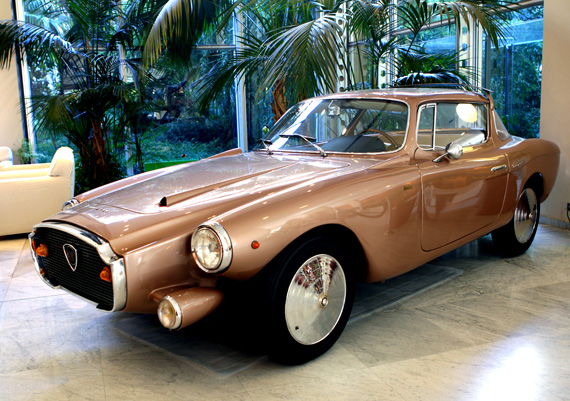
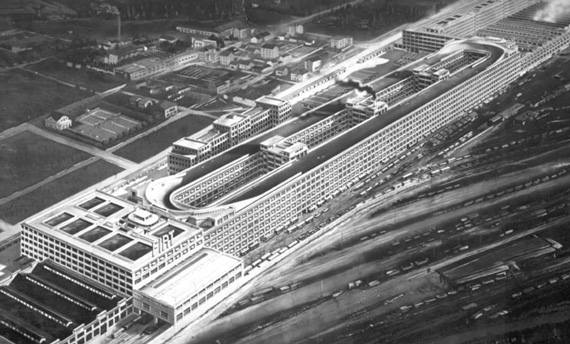
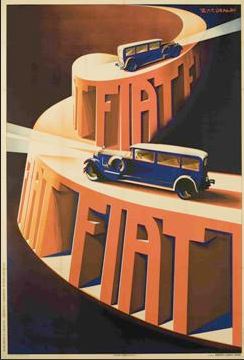
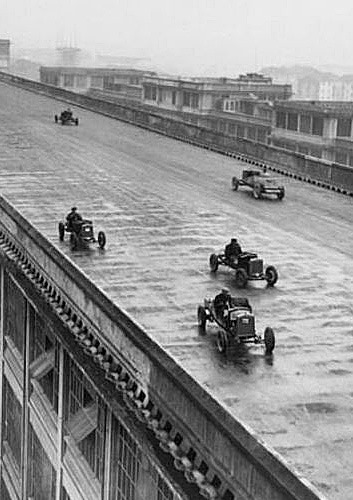
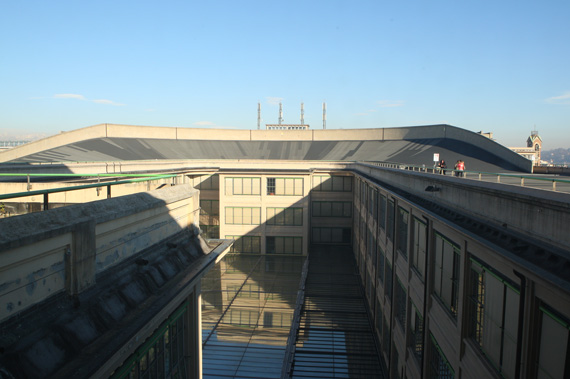
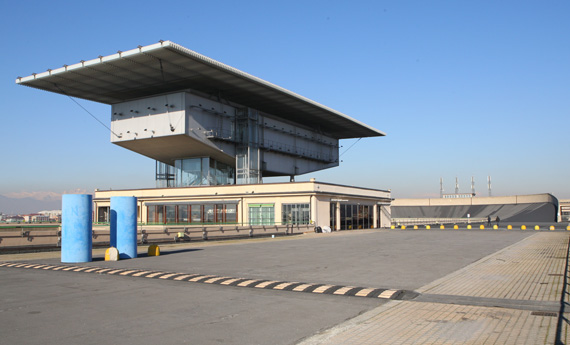

The building looks beautiful but that car is quite possibly the most hideous thing on four wheels that I‘ve seen in my life; and I’m 64 years old.
There is (was) a book on the Autosalones in Torino:
http://www.amazon.it/dellAutomobile-Valentino-Lingotto-Presentazione-Giovanni/dp/B008F8RO4Y/ref=sr_1_13?s=books&ie=UTF8&qid=1390332697&sr=1-13&keywords=Lingotto
The second part (approx.) 60 pages, deals with Lingotto with interesting photos..
And it shows the models for the architectural contest for further development of Lingotto, which Renzo Piano finally won..
Best regards Michael
Ron; I have to disagree.
While the long nose looks awkward, the shape can grow on you, and given that Loewy was nothing if not a showman, and this was the tail end of the fifties, it is no better or worse than many other one-offs of the time.
Yes, he did say that parts of the design may have influenced the Studebaker Avanti which today is recognised as one of the best looking of any sports coupe made in America, and yes, it is certainly nothing like the classic Lancias by PininFarina, Bertone or Zagato, but as a styling exercise I think it quite successful.
It is just a shame there are not more such daringly different designs to choose from today.
Google some more images and have another look Ron, you might get to like it.
Being a Fiat tragic, I had the pleasure of staying at the beautiful NH Lingotto Hotel in July last year, staying there for 3 nights. My friends and I thoroughly enjoyed the experience, which was capped off with a walk around the roof.
I have to go with Ron here. Chris also has a point and other photos of the car show it to be quite pretty but only up to the headlights!! The factory on the other hand is very neat. Google maps has great views overhead as well as street views. Check it out. Thanks Pete for bringing us these wonderful articles.
Dear Peter Vack,
An inquiry as to whether you would allow the article, “A Visit to Fiat’s Remarkable Lingotto”, to be sent to FIAT Club of NSW, Australia, members? At a recent meeting three club members showed a power point of their visit to Lingotto. This text and photos would therefore be of great additional interest. Of course I would make sure VeloceToday and you were credited with authorship and original publishing.
P.S. I own an A, B and C model Topolino.
For your consideration,
Regards,
Ian Howard
Ron,
I’m with you mate – it’s a stinker. And yet…
It at least has some character, something which has essentially been lost on today’s bloated ciphers. Cars seem to have gone the way of the biccyle, all being tiny variations on a unversal theme. And what happened to charm, or (whisper it) beauty? Why the unending queue of aggressive, assertive horrors? Maybe that’s why I drive a Lancia Fulvia as my daily driver, which is of course directly related to the Laraymo in time and lineage; which is where we came in…
Best wishes
Will
When a few minor things were being done to my Flaminia Zagato at the Lancia works, I noticed a shape nearby under a dusty tarp. The men pulled it back and there was the Loraymo, which I’d seen in a magazine article a year or so previous. “Would you like to buy this?” one asked. I said no, it wasn’t very nice looking, and they glumly agreed and covered it back up. I sure think it was silver-gray at that time, though I could be wrong: there was more dust under the cover than on it!